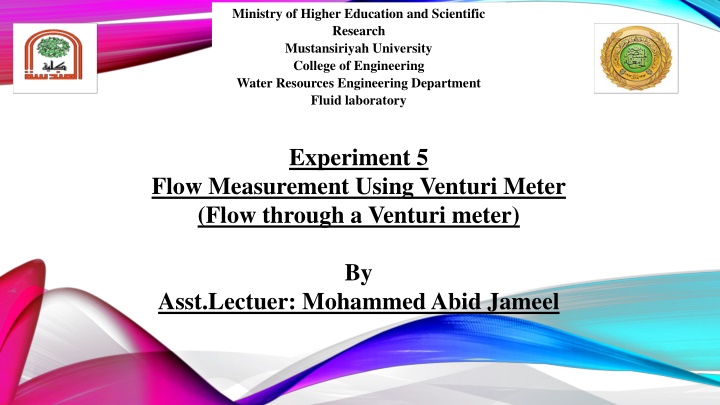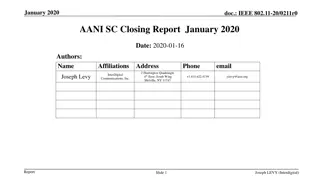
Venturi Meter: Principles and Flow Measurement Experiment
Explore the principles of a Venturi meter and learn about flow measurement using a Venturi meter in a fluid laboratory experiment. Discover how to determine the discharge coefficient (Cd) by comparing actual and theoretical flow rates.
Download Presentation

Please find below an Image/Link to download the presentation.
The content on the website is provided AS IS for your information and personal use only. It may not be sold, licensed, or shared on other websites without obtaining consent from the author. If you encounter any issues during the download, it is possible that the publisher has removed the file from their server.
You are allowed to download the files provided on this website for personal or commercial use, subject to the condition that they are used lawfully. All files are the property of their respective owners.
The content on the website is provided AS IS for your information and personal use only. It may not be sold, licensed, or shared on other websites without obtaining consent from the author.
E N D
Presentation Transcript
Ministry of Higher Education and Scientific Research Mustansiriyah University College of Engineering Water Resources Engineering Department Fluid laboratory Experiment 5 Flow Measurement Using Venturi Meter (Flow through a Venturi meter) By Asst.Lectuer: Mohammed Abid Jameel
1. Introduction: A Venturi meter is a tube with a constricted throat that increases velocity and decreases the pressure. Venturi meter is used for measuring the flow rate of both compressible and incompressible fluids in pipeline. For example, the Venturi meter is found in the wastewater treatment plant. 2. Objectives: The objectives from the implement of this experiment are study the principles of Venturi meter and to determine its coefficient (Cd) by comparing the measure flow rate (Qactual) with the ideal flow rate (Qtheortical). Typically, the discharge coefficient (Cd) has a value between 0.92, and 0.99. The actual value of Cd is dependent on a given Venturi meter, and even it may change with Qactuual.
3. Theoretical Aspects: 3.1. Theoretical background: As shown in figure (1), the Venturi meter is used for measuring the discharge in the long pipe. It is consisting from converging cone (contraction section) with angle about (15-20o). This section is accelerated the fluid and lead it to a throat section, which has cross-sectional area smaller than the pipe (the flow area is the minimum), so that, the fluid velocity through the throat is higher than that in the pipe. This increase of velocity is accompanied by a fall in pressure, the magnitude of which depends on the rate of flow, so that by measuring the pressure drop (the pressure difference between the upstream side of the cone and the throat), the signal for the flow rate is provided and the discharge is calculated. Then the fluid slow down in a cone with smaller angle about (5-7o), where, most of the kinetic energy is converted back to pressure energy.
Figure 1. Illustration of Converging Cone and Throat Section in Venturi Meter 3.2. The Equations: By applying the Bernoulli equation, the theoretical discharge (Qtheoretical) is calculated from the following equation: 2 ? ? ? "( 1 2) ?? ?????????= ?1? ?2? (1) ?12 ?22
Where: Qtheoretical= the theoretical discharge (ideal) (m3/sec). A1= the cross sectional area of entry (upstream or converging) section (mm2) (A1= 31.76 mm2). A2= the cross sectional area of throat section (mm2) (A2= 15 mm2). h1= the manometer reading (head reading) across the entry (upstream) section (mm). h2= the manometer reading (head reading) across the throat section (mm). h1-h2= The differential manometer reading (mm). In practice, there is some loss of the energy between section 1 and 2. Therefore, the measured values of Q usually fall a little short of coefficient Cd which is introduced as follows: Qactual= Cd . Qtheorotical (2) Where: Qactual= the actual discharge (m3/sec). Cd = the discharge coefficient.
4. Experimental Work: 4.1. Equipment and apparatus: Figures 2 show the details of the Venturi meter. Water enters from the hydraulic bench to the Venturi meter which consisting of a short nozzle, a throat, and a long diffuser. Next, the water flows into a rapidly diverging section (C-D) followed by a settling length where the flow again adjusts to uniform conditions. Figure 2. The Venturi Meter Used in the Experiment
4.2. Procedure: 1. Stand the apparatus on top of the hydraulic bench. Connect the bench supply hose to the inlet pipe and secure it with a hose clip. Connect a hose to the outlet pipe and put the other end of the hose in the hole leading to the bench volumetric tank. 2. Open the outlet valve, then switch on the bench pump and open the bench supply valve to admit water to the apparatus. 3. Partly, close the outlet valve, so that water is driven in manometer tubes. Then, carefully close both valves so that you stop the flow whilst keeping the levels of water in the manometers somewhere within the range on the manometer scale. 4. Level the apparatus by adjusting the leveling screws until the manometers each read the same value. 5. Open both valves (inlet and outlet) and carefully adjust each one in turn until you obtain the maximum differential reading (h1-h2) whilst keeping all the water levels within the range on the manometers scale. If necessary, adjust the general level by pumping air pipe into the reservoir or releasing air. 6. Record the manometer reading (h1, and h2). 7. Measure the flow rate (Qact) by timing the collection of water in the bench volumetric tank.
4.3. Data Sheet: The table (1) is represent the data sheet for this experiment: Table (1). The Date Sheet Time (sec) Vol (L) h1 (mm) h2 (mm) Ran 1 2
5. Calculations and Results: 1. Calculate Qact by using equation (Qact=Vol/time). 2. Calculate the cross sectional area of upstream section (A1) and throat section (A2) by using equation (Area=?/4d2). 3. Calculate the differential between reading (h1-h2). 4. Calculate the theoretical discharge (Qtheortical) by using equation (1). 5. Calculate Cd by using equation (2). 6. Calculate the average of the discharge coefficient by collecting the calculated runs and dividing it on the readings number. 7. Plot the relationship between the actual flow rate (Qact) versus the root square of (h1-h2)1/2 and finding the slope from linear equation for graph then calculate Cd (again) through by using equation (3) and comparing it with Cd average. The table (2) is represent the results for this experiment.
Table (2). The Experiment Results h1-h2 (mm) Qact (m3/sec) Qtheortical (m3/sec) Cd Ran (Eq 2) 1 2 Cd average ?1??2 ?? ???? = ?????/ ? 2? (3) ?12 ?22
6. Discussion: 1. Is there a difference between the values of Qideal calculated by equation (1) and Qact using equation (Qact=Vol/time)? Why? 2. Is there a difference between the values of Cd average and Cd graph ? Why? 3. Why the relationship in the plot is linear between the actual flow rate and the root square of (h1-h2)1/2? 4. Why used the slope value of the graph for calculate Cd again using equation (3).
Thnke you Thank you











